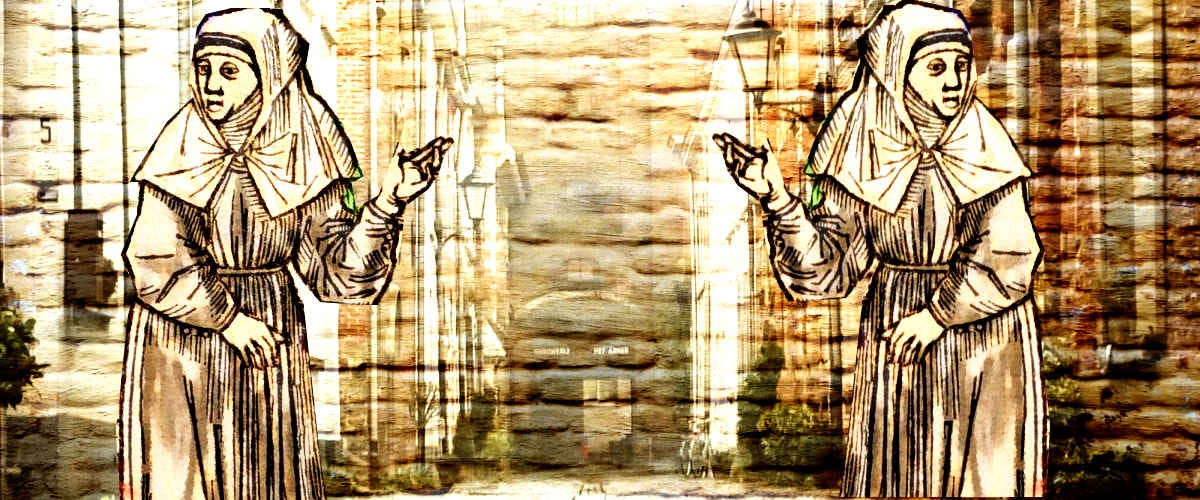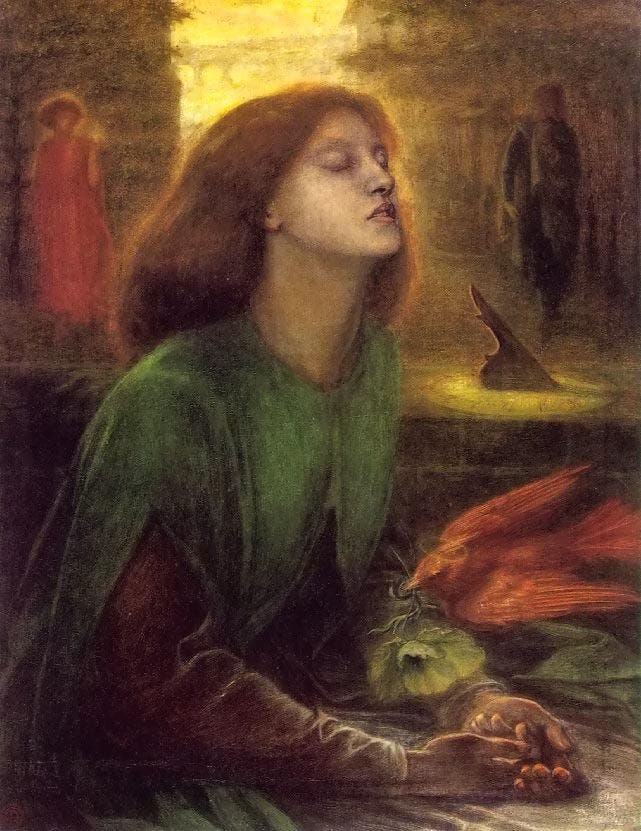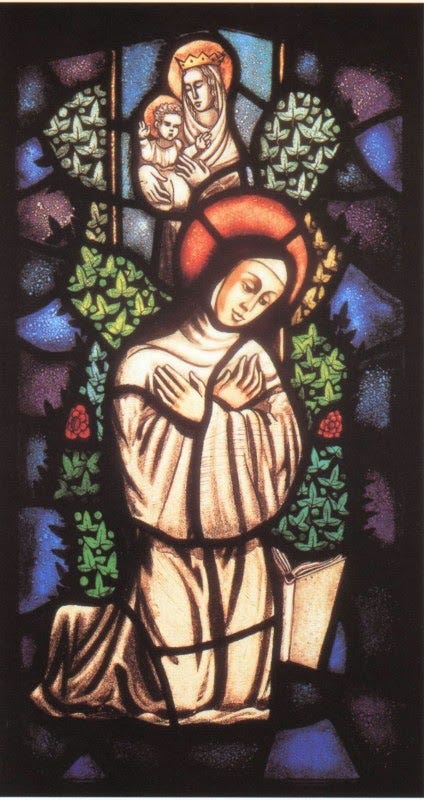**A quick note: For those of you in Austin who were planning to attend tonight’s Contemplative Blue Christmas service, it has been canceled due to illness. I’m so sorry, as I was really looking forward to it. Keep an eye on our Facebook page for a rescheduled date in January.**
And like the fish, swimming in the vast sea and resting in its
deeps, and like the bird, boldly mounting high in the sky, so
the soul feels its spirit freely moving through the vastness and
the depth and the unutterable richness of love.
Advent Day 19: Beatrice of Nazareth (1200-1268)
In the early 13th century, a feminine spiritual revolution swept Belgium and Holland, led by the Beguines. Beguines were lay women who organized their lives around action (serving the poor) and contemplation (meditative prayer). They lived communally, took informal vows of poverty, and dressed in humble garb. Rather than cloister themselves like nuns, they immersed themselves in their local communities. While Christian, they pledged allegiance to no established religious order. This allowed the flourishing of a kind of free-wheeling spirituality where each group’s and individual’s religious expression looked a bit different, according to their unique path. In this fertile spiritual field grew Beatrice of Nazareth.
Beatrice was born in 1200, in the Flemish Duchy of Brabant. The youngest of six children in a wealthy family, her schooling was organized and overseen by her mother, Gertrudis. But when Getrudis died in 1207, Beatrice was sent to the Beguines of nearby Zootleeuw. There she was introduced to a religious path that encouraged the experiential, boots-on-the-ground faith of Jesus. She also observed firsthand the wide range of reactions evoked by the Beguines’ DIY religious path, from adoration to disgust. This early experience planted in Beatrice a taste for spiritual freedom, and a spiritual courage in forging her own path.
As inspired as Beguine living was, due to its informal nature it lacked scholastic rigor. So, when she was a teen, Beatrice’s father moved her to the Abbey of La Ramee. There she came under the tutelage of noted mystic Ida of Nivelles who’d also spent her formative years with the Beguines. As a confidante and spiritual advisor, Ida encouraged Beatrice to cultivate a heart- rather than head-centered faith. This was the most influential relationship of Beatrice’s life.
At sixteen, while meditating on the Psalms, Beatrice had her first vision, a kaleidoscope of images: Jerusalem as heavenly city, angels, a visual representation of the Trinity. This taste of God’s presence lasted a moment but felt like forever. When it was over, Beatrice was flooded with gratitude and joy. She fell into fits of laughter. But soon the laughter gave way to sobbing from fear that the vision was a one-off and that, at sixteen, she’d hit her spiritual peak and would never feel God that close to her again.
A long depression followed this first vision during which Beatrice applied herself to extreme fasting and other intense ascetic practices. This was the Middle Ages, the golden age of penitential excess when people starved themselves and wore hair shirts and thistle girdles, and generally made themselves miserable to prove their devotion to, and identification, with Jesus. Beatrice was on board with much of this. She believed that by performing great feats of devotion, she could rid herself of all her temptations and faults, and in so doing earn God’s love. And maybe then get another taste of God’s presence like she’d experienced in her vision.
Eventually, she did have another vision. Then another, then more. Some were random and abstract. Some were simple and plain, like one in which Jesus embraced her and said, “Let us make a pact that we may not be separated from each other, but that we may be truly unified.” After each, Beatrice cycled manically through the same stages: joy, gratitude, grief, fear. Then she would start all over again with her athletic devotions, to try and will God into noticing and loving her.
Finally, after years of this, God basically told Beatrice she needed to calm down. This was in a vision where she was given to understand that a) God was always with her, always present and, b) he loved her for her, and not because of how long she could last without food. Wrecking her health with fasting or winning the gold medal in holy self-harm would not make her any more beloved than she already was. And not only was she loved so extravagantly, everyone was. That was the point! God was Love! And God had created the whole cosmos out of love and for love. All of it—Beatrice included—was made for love, and love alone.
This rocked Beatrice’s world. At last, through love, and by trusting love, she was liberated from fear, and the gnawing feeling she was never enough. This is not to say her dark nights ceased. There were more. But those to come were shorter and shallower, and she always emerged from them with a deeper insight. She even came to realize that all the personality flaws she tried so hard to shake and never could—well, maybe even those were gifts from God. Maybe by accepting them and smoothing their rough edges rather than trying in vain to eradicate them…maybe this was the deeper way to holiness.
In 1236, Beatrice co-founded along with her father and siblings the Notre-Dame-de-Nazareth abbey where she served the rest of her life as prioress. By then she had gained a reputation for deep insight and wisdom, and was often sought out by others. Around this time, she began to write down her thoughts on the spiritual life. Most have been lost and are only known due to being referenced in the writings of others. But one survives: The Seven Ways Of Loving, a mystical masterpiece in which Beatrice describes her lifelong climb up the ladder of love toward union with God.
1st Way: Longing for love. In this first stage, we long for connection with God. And any connection we feel is never enough. We will always long for more. After feeling this love for the first time, we will naturally begin searching to find it again. Beatrice is clear that the way to union with God is through love, not fear.
2nd Way: Offering of oneself. As we experience more tastes of the Divine, we seek less to please ourselves and more to please, serve and be in gratitude to God for the gift of life.
3rd Way: Suffering for God. But, try as we might to live into Step 2, we have the nagging feeling that who we are and what we do can never be enough. There is simply no adequate way to express gratitude for creation. This leads to frustration.
4th Way: Taking joy in God’s love. Eventually, however, through prayer and meditation and spiritual maturity, that frustration gives way to a kind of rebirth, a fresh awakening to Jesus’s love for us. This awakening fills us up with love for God and increased love for others and all of creation.
5th Way: Accepting that suffering comes with love. Thus awakened, we seek ever more and deeper love. In a more mature version of the 2nd way, we apply ourselves to all the methods that have helped us connect with God in the past. But, as we can’t be in a state of meditative practice all day, this leads to a different kind of suffering. We can be resentful of any activity or obligation perceived as a barrier to reaching God.
6th Way: Resting confidently in God’s love. In time the 5th Way gives way to a more relaxed and assured intimacy with God. We come to trust that God’s love sustains us in every single moment. There is nothing we can do to earn it or will it into being. This intimacy follows us through the day whether we are aware of it or not, and is just as present when we’re washing dishes as when we’re taking communion or doing meditation.
7th Way: Bringing longing full circle. In our human lives we can never fully know, but only guess at, the Beauty that awaits us. However, we will never stop seeking to know what we can of that Beauty while we are here on this side of the veil. So, the 7th way brings us back to longing. Only now, in this stage, it is a mature desire, without the frenzy, frustration or fear of the past, with only a wish for deeper love. And since there is no bottom to love, we are always left longing.
To be clear, Beatrice is describing her own path. Everyone’s path will look different. Yet her journey bears much resemblance to the spiritual phases described by other mystics through the ages, including the Four Degrees of Ascending Love of Bernard of Clairvaux and the Interior Castle of Teresa of Avila. Maybe you will recognize something of your path in Beatrice’s, too. It’s also worth noting that spiritual growth is never a straight line. The seeker will sometimes advance, sometimes retreat. And even as she advances, she carries elements of previous Ways with her. She transcends the limitations of one Way while including what’s healthy and worthwhile from it in the next Way.
In Beatrice’s spirituality, healthy desire became the means and method by which she ultimately sought and found God. Through much emotional trial, she awakened to realize that an endless, unsatisfied longing is a good thing in the spiritual life. It keeps us searching. It calls us toward ever deeper love. How can our spirits be satisfied to remain still when we know there is always a new depth to plumb? This is why, as Jesus said, the poor in spirit are blessed and theirs is the kingdom of heaven. Because the poor in spirit know there is no end to love, and so there is no end to longing. And if that’s not heaven, I don’t know what is.
Advent Practice
Consider the first of Jesus’s Beatitudes from the Sermon on the Mount: Blessed are the poor in spirit, for theirs is the kingdom of heaven.
We don’t typically consider being “poor in” anything to be good. But here Jesus is clear that those whose spirits are in a state of lack are blessed. Not only that, but theirs is the kingdom of heaven—present tense.
For today’s practice, meditate, pray or journal on this passage. What does it mean to you? Do you feel poor in spirit? If so, do you perceive this as a bad thing? Is there a way that being poor in spirit might serve to call you into deeper connection with God and others?
Holiday Happenings at Life In The City
Dec 21, 7 pm:Blue Christmas, a contemplative service for the darkest night of the year.Canceled due to illness.Dec 23, 6 pm: Christmas Eve-Eve candlelight service, an annual LITC tradition.
Dec 24, 11:15 am: LITC’s regular Sunday service.
Dec 31, 11:15 am: A fun, casual service with cookies and coffee to welcome 2024.
Ready For More?
Read the Introduction to the 2023 edition of The Heart Moves Toward Light: Advent With The Mystics, Saints and Prophets.
Find more mystics, saints and prophets in our Archive.
Feedback
Did you catch a typo? Do you have suggestions for mystics, saints and prophets we might cover in the future? Leave feedback in comments section below or email Greg Durham at greg@lifeinthecityaustin.org.








